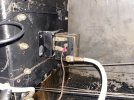You're likely dealing with a ****ty voltage regulator that is on its way out.
I have experienced the exact same, the original voltage regulator and overvoltage protector went their own way.
Mind you the voltage regulator provides the "field voltage" to the alternator to tell it what of its production to provide.
I don't mean to stress you but it is something you want to take care of, especially if it is an original one and get
this.
If you have it done, its about a 1000 exercise but worth it. I had the regulator fail during flight one time, running on battery only with retract gear
man I tell you the stress add it gives.
The battery voltage doesn't rise over time, it is likely your regulator/alternator that is affect here.
And the concord batts btw are solid, I had to replace one after 5 years of usage, as I was running it dry especially in winter time though it recovers nicely
WITH a good alternator/regulator. Look at those first.
Simple test you can do is to hook up a voltage meter on the field lead of the regulator/alternator and see what it says, I betcha that one is not going to show what you need (is 13.9V)
xander

